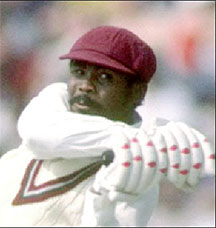Bridgetown, Barbados – Former West Indies opening batsman Gordon Greenidge on batting at the top, playing India’s spin quartet, and that Lord’s chase in 1984.

Subash Jayaraman: What is essential for an opening batsman, in Test matches, especially?
Gordon Greenidge: You have to have a serious portion of self-confidence to get the job done. You have to be technically able to withstand the pressure and know when to apply pressure. It is not a position a lot of people would put their hands up and say “Yes, I will do it.” You need to set the tone for the day and a platform for the team to build on.
SJ: The odds of failure are much higher when you are opening the batting and the ball is swinging all over the place. How does one gain that confidence?
GG: It is not that you get thrust into that position. It takes a special type of person to want to do that job. You know, you have to be very focused technically, well groomed, and be able to absorb a lot of tension and pressure that goes into the job.
SJ: I am assuming you can put pressure on the opposition in two ways – by attacking the bowlers and scoring a lot of runs, and where you defend all day and not give them your wicket?
GG: I don’t think defence is more “all day”, but some days or games where you have to bat very hard because you need to keep the opposition out there and develop a score, because the pitch and the conditions may not be suitable to the way you want to play. It means you have to curb your normal way of play and be very stubborn and focused to get the job done. That technical side of you is what is going to carry you through.
SJ: We have seen batsmen of all kinds open the batting. Some very aggressive, some very defensive. How do you define that balance?
GG: I like to feel I am going to take the fight to the bowlers. I believe when I take the fight to you, I make you change your game plan. It didn’t always work, of course, but I thought this was the best game plan for me.
SJ: When would you say a batsman is ready to open in Tests, in terms of age, experience, the amount of first-class runs?
GG: A lot of individuals choose where they prefer to play. That is not the case with Nos. 1, 2 and 3, because those are the positions for people who are groomed, who groom themselves. Persons at Nos. 4, 5, 6 or 7 could alternate, because they are very similar positions. I only batted down the order a couple of times when playing international cricket. I am not certain I would be suited to go in any lower than 1 or 2, because to have sat there waiting to go in would not have worked out for me.
SJ: Was there a point in time where you thought, “I am made to be an opening batsman”?
GG: Not made to be. I wanted to do it. I couldn’t honestly feel I could have been anything other than an opening batsman, regardless of whether someone thought my technique to be good or not as good as it should be. I tried to make that position my own. If anyone wanted to come into the team, it had to be a case where someone was seriously ill, or had an injury, because there is no way I would give my position to someone else.
SJ: What was the role of county cricket in sharpening your role as an opening batsman?
GG: I suppose what helped is the regular games you had to play on varying types of wickets. There were seasons of county cricket on uncovered pitches; they started the season with pitches which were very green, and some of them played very true; some played low, some seamed a lot. So from season to season, you had to make some adjustments to the game. That helped make my game more compact.
SJ: What was the role of beach cricket in your youth?
GG: One of the favourite things of beach cricket is that some guys stood more on the back foot, because the bowler was waiting for the water to come on to the hard part of the sand and the ball just skidded. They would bowl very short and the batsmen just sat back on the back foot and pulled or cut. I wasn’t a great puller or cutter. I was more of a front-foot player. I did play a lot of beach cricket, it was fun. Beach cricket, or cricket at the school in the evening, used to last for weeks. Guys used to bat for weeks. If you couldn’t get them out, the next day you can’t get the bat back.
You had to learn to bowl your heart out. It is only the person who bowls who gets a chance to bat. If you are fielding for the whole while, you are not going to bat.
SJ: How did you switch on and off between deliveries in Test matches?
GG: You focus on various things around you, like the pitch. You gather your thoughts. The hardest one is after each session, because after you have sat for a while you have to come back and say, “This is the beginning of the innings.” You cannot and shouldn’t be saying, “I am continuing from where I left off.” Yes, runs are on the board, but the whole cycle has to start – your feelings, your footwork, the coordination, the timing on the ball.
SJ: Opening batsmen generally tend to be really good at facing pacers and seamers and not so good perhaps against spinners. In your time you had to face some of the best spinners in the game, especially against India. What did you do to prepare against them?
GG: Technique comes in to play again. You have to develop that skill. I am happy to have gotten the opportunity to play against the great spinners in that time. India had four excellent spinners, and that was my first tour. There is a sense of fear when you play these spinners, because you know the calibre of the players you are facing. But you have to play what is happening on that day. You can’t go that far back anymore because then you are just playing the experience and the calibre of the person in the past. Today may be the day that the person is not spinning so much, his length is not good.
I was a big reader of spin. I did use my feet when I thought it was necessary, and was very watchful of the ball. I read more off the pitch than in the air. I was able to cope with it reasonably well. In that first tour, it did me a lot of good to deal with the four great spinners that India had. I was able to survive and score runs.
SJ: Were there subtle changes in your technique, depending on whether you are playing in England or Australia or India, in terms of movement in the crease and the grip on the bat?
GG: Not too much movement in the crease, as you have to stay still. Your head needs to stay still when you are watching the ball to get a better view of what is happening. To move around the crease, you may bat leg stump, sometimes middle and leg, sometimes middle stump, or your head goes a little further to the off stump than where you are looking at. I don’t want to play too many balls out of my line of head, especially if the ball is shaping away. Even so, you need to be watchful, because some balls go straight and some will come back. I am certain that bowlers delivered deliveries to shape away from the batters, but it may hit the wrong side of the seam and cut back at you. You have to watch very carefully.
SJ: As a front-foot batsman, what were the shots you liked to play and shots you avoided?
GG: It depends on the delivery you receive. Don’t premeditate. When you have seen the delivery, your experience and practice will tell you this is the shot you are playing to it.
SJ: Did you ever compare yourself to other opening batsmen of your time, like Sunil Gavaskar?
GG: I don’t make comparisons. You look at those players and appreciate how they got their job done. Some looked very subdued, very quiet in their approach, and some were explosive. You develop your skills the best way you can and deal with it. A lot of people didn’t want to be [Geoffrey] Boycott. I thought he was technically excellent. Boycott could play a lot of attacking shots when he got in the mood. England would be very happy he was in that position, because otherwise they would have been bowled out for a much lower score.
SJ: Could you talk a bit about your partnership with Desmond Haynes?
GG: We didn’t see a lot of each other outside of cricket, although we didn’t live far apart. But the team, the dressing room, the camaraderie, the relationship, the partnership was good. A great understanding had developed over a number of years. There were times where we felt we didn’t call enough. We looked up and mostly knew it was a yes and we could have run it. It is not something that you want to practise or have the youngsters practise. It was just an understanding that had developed over a number of years. He would sometimes be the aggressor, or I would. We always had a battle on. He wanted to face the first ball, and I would say, “No, you haven’t matured yet.” I wouldn’t just let him.
SJ: There might have been spells or times when one of you says “You are not in the zone”, so you let the other batsman take the strike as much as possible.
GG: That has happened on quite a few occasions. We were able to rotate to make sure the person who was playing better on the day received more of the bowlers who were more troublesome in that particular case.
SJ: You had Viv Richards, Clive Lloyd and Larry Gomes coming after you. Did that free your mind to go out and play?
GG: It was a case where you played the game the way you want to play. That was the freedom given to the players. Don’t be inhibited in any way. This made you happy and comfortable. I think in that 16-year period we didn’t play more than 25 or 30 players at the most. That is perhaps not heard of.
SJ: Could you elaborate on that Lord’s innings and whatever else sticks in your mind as being your very best?
GG: The Lord’s Test in 1984 wasn’t a planned situation. The score of 340 runs in two sessions and maybe an hour – it is not a score that you will say: “We will measure it.” There is no way that you could have done that. You could have liked to start off with a flurry of runs and developed the score before the first break. You hope you can reach that so you can give a more forceful challenge in the next two sessions. It wasn’t like we sat down in the dressing room saying, “We will do this.” I cannot recall exactly how it happened. I saw what was coming, played a shot to the delivery. I got dropped in the latter part of the innings. You play the game the way you saw it.
On my part, there was an innings in 1976 at Old Trafford that was more planned. We ended up getting bowled out for just over 200 runs. I batted right through the innings. That innings was more set in my subconscious than anything else, because of what happened in that particular match. It wasn’t a pitch where you should be bowled out. The bowler wasn’t a demon bowler, he was a seam bowler. We weren’t pressured in any way. That was one of those days where you could not have foreseen what happened. We lost so many wickets in such a short time for so few runs. It meant that the battle was twice as hard.
SJ: In the Lord’s Test, it wasn’t some random bowlers. You had Bob Willis, Ian Botham, Neil Foster and Derek Pringle coming at you. And it was a day-five pitch. Once you got in and got a flurry of runs and got to the first break, what was your thinking process when you came back out?
GG: We were only about 40-odd runs in the first session. We still needed 300 runs. We just wanted to bat out the next two sessions and not create a crisis out there. It could have easily happened that we could have chased down the next 290 or 300 runs in two sessions. But come on, it may occur now, because teams are scoring 400 in a day, but back then if you scored 300 in a day in the first innings, you did exceptionally well. It was either a case where you had runs, maybe seven wickets, or you got bowled out. If you are looking at 280, you did very well in the day.
Yes, you knew the calibre of the bowlers. But like I said, you don’t play the man, you play what you see, regardless of the reputation. You know what you can do. But you play what you see. If you play the calibre of the bowler, then you are probably 30% to 40% beaten already.
SJ: Haynes gets out when the score is 57. Larry Gomes comes in. There is a phenomenal partnership. You go for the next session break and come back out. Now it is a definite possibility that you can take it down. What was said in the dressing room?
GG: Once we got to the last hour, we probably had less than 80 runs or 100 runs to get. We still had nine wickets and we thought: we’ll give it a thrash. We had to continue playing how we were playing – start all over again, playing what you see in front of you at the time. We got a chance to increase the tempo and we did that. You don’t plan it. I can’t think anyone is going to plan 340 runs in five hours, regardless of who you are playing against.
Larry is a very pragmatic player. He was quite explosive in that innings as well. A lot of you don’t look at the way Larry played, the role he played. The sort of mentions that I get for what I did… Larry played an exceptional innings too. When we discussed the matter about him getting his hundred, it wasn’t a matter to him at all. He said, “Let’s get the game over with.” That was brilliant. History was to be created that day, and we had done so. (reprinted from Cricinfo)







